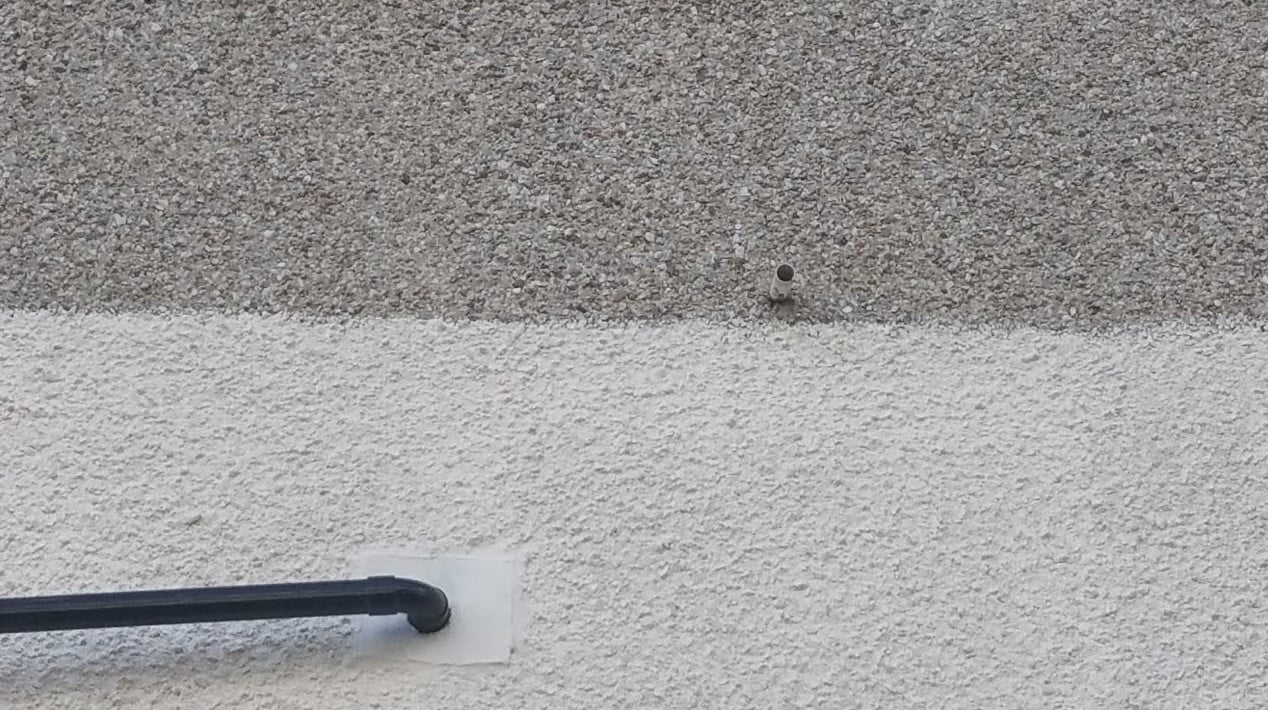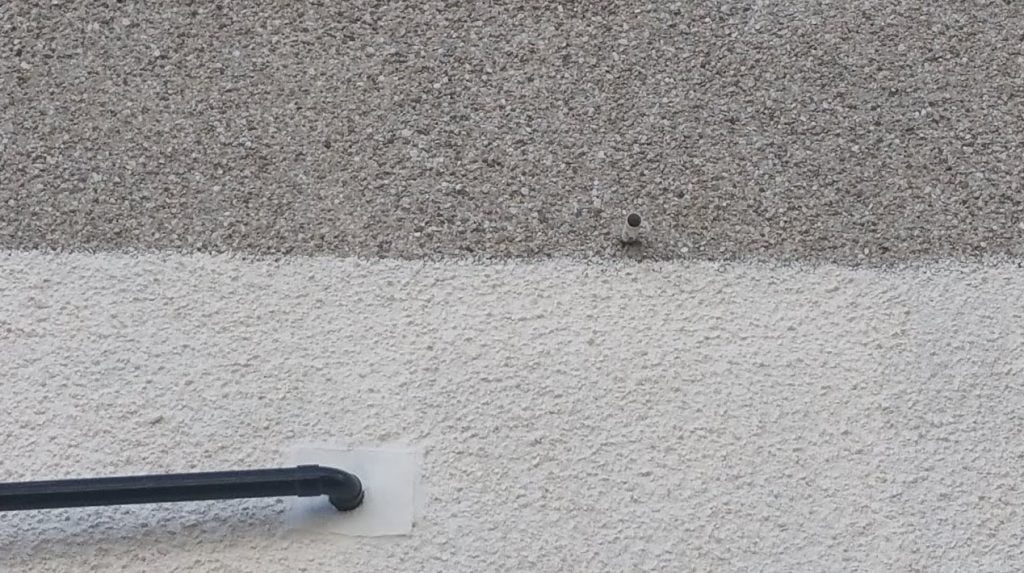Free Call Now

Your pebbledash has never been painted and is starting to crumble. Its last paint job was awful and you can't look at it any longer. You want a fresh look for your exterior walls. Any reason is good enough to start jotting down your masterplan, with a little help from these top tips for painting pebbledash.
Let's be honest, painting pebbledash is no walk in the park. But what a difference it can make! If done the right way, that is. Hang around for some useful advice and you'll manage like a professional.
Contents
Depending who you turn to, you'll get all sorts of advice on what tools are required for painting pebbledash. Using a masonry brush to paint your whole wall, for example. That would actually do a great job, only you'd have to have some serious stickability as well as time on your hands. A whole summer's project? Even if that sounds right down your alley, it may be best not placing bets on three weeks solid of a dry spell. Unless you've relocated to Australia lately. For UK home birds, here is a tried-and-tested way to tackle your pebbledash walls.
So what will it take for you to apply paint on to your four walls without it turning into your worst nightmare? Or ending up with a blotched finish, or both? Start off with the right equipment and you're setting yourself up for success. Here's your shopping list:
Ok, we've grouped some of these to make the list look shorter. And yes, it's an investment. But one that will save you money in the long run. Here are a few explanations why, item by item:
A clean wall is what it takes to make sure your carefully-picked paint will look the part once on. It won't delay you any, but rather make your efforts pay off for longer. You'll have to wear protective clothes and glasses because the water jet may be firing lose parts back into your face.
See this step as a plus point. 'Testing' your wall like this can highlight weak spots where pebbles are coming off. And ultimately get them fixed. So yes, you're actually facing a bit of maintenance aside from the painting part proper. Rest assured it's for a good reason and read on to find out why.
You'll need masking tape to cover your doors and windows before applying paint onto your wall. Our top tip for sealing the masking tape is to run a damp cloth along it. Take the time now and you won't need to scrub off dry paint once you're finished.
Bonus: the tadaaa! effect when you remove the dust sheet from the ground and peel off the tape to reveal a pristine new façade.
In case your pebbledash is made of chippings rather than individual pebbles, it will display sharp edges all over. Whatever the case, it's a good idea to wear protective gloves to stay on the safe side. Your goal is to stay focused on the job without having to take breaks to mend cuts and bruises.
You'll need one no matter what. A 2.5 to 3 inch-wide brush is what you want. An angled-tip type will make for a super neat job. Having said that, a brush with square ends is fine, too. The aim with a masonry brush is to apply a substantial volume of paint and work around the pebbles easily thanks to its good length and flexibility.
You should go for either a 6-inch or a 9-inch roller. The longer the roller, the quicker you'll have the surface area covered. In that sense, a 9-inch long-pile roller is the Rolls Royce of rollers when it comes to painting pebbledash. Still, a 6-inch roller model can do the trick if you're not used to lifting weights. For painting pebbledash, you have to ensure your roller is long pile, which will help get in and around the pebbles for a class A finish.
You'll be keeping your gallons of paint to one side, pouring paint into a bucket where you'll feed it into your roller tray. This way, any lose chippings or dust coming off the wall won't spoil your whole tub. Even though they shouldn't after power washing, right? But better be safe than sorry, so we figured this helps.
Especially if you take a step back to contemplate how far you've come and knock off the bucket - it keeps spillages to a minimum. As you're about to find out, there is method to this madness!
Where paint is concerned, get the cream of the crop only. If there is one thing where not to cut corners, this has got to be it. Good masonry paint is a must as it will look great and last for ages.
It's best having an extension pole and a good ladder among your equipment. Use the ladder to get at the highest parts of your wall and the extension pole to apply paint more smoothly and - sorry for stating the obvious - give you a higher reach. A grade 2 ladder is necessary for stability, as a grade 3 model may not live up to the strains of an exterior job.
As for the telescopic pole, watch out for its weight. Your 9-inch roller may be enough for you to handle without adding on unnecessary pounds. An aluminium pole should minimise this. The locking system should be user-friendly so try it out first or else pay close attention to detail when shopping online.

You've had a quick overview of what's involved, now let's get some tips on how to get the job done right without sweating blood, sweat and tears over it.
First things first, you'll have to knuckle down and get the walls cleaned. Again, for best results and to save you valuable time, we strongly recommend using a power washer. If you don't own one, it's easy to rent one out for a couple of days.
Make sure to fill any cracks with a mortar mix. There are ready mixes available out there but don't hesitate to outsource this part of the job if big parts of your pebbledash rendering are hollow. Painting over it wouldn't address the problem of dampness seeping into the house, therefore you may want to get it assessed. Preparation is key, so you need to take steps to achieve a healthy rendering first and foremost. Then only you can move on to the next step...
Which is to lay down dust sheets on the ground and apply sheeting onto your doors and windows, securing them with painter's tape. Pat on the back for getting this far... and now the fun can start!
So your wall has been hosed, filled in where applicable and your work surface prepared.
The perfect dry day is waiting for you to get cracking. And by this, we don't mean bright sunshine. In painting terms, you want a slightly overcast and dry day, allowing you to work without being blinded or having the paint dry too quickly.
Even if your pebbledash has been painted before, start afresh and think two coats.
Your first coat acts as a primer, allowing the second coat to stay on the pebbledash as opposed to get sucked right into it. Spending the time now is a guarantee for your lovely cream, or white, or any colour of choice to last a dozen years rather than just a couple. Your investment in time and efforts will stand the time of time.
Use your masonry brush to cut in around any dividing lines such as windows, doors and gutters. For a firm grip, hold your brush on the flat part where the bristles meet. Now you're ready for steady, methodical strokes. Always start at the top and work your way down. This lengthy process pays off once your roller blends in to each corner as if by magic. You'll see!
Have a quick-access bucket nearby at a safe distance from the wall to avoid potential lose chippings from falling into it. This is a sure way to keep your precious paint safe. In case of spoiling you'll lose just a fraction of it. Sigh of relief. All you'll have to do is simply refill your bucket with paint from the tub as you go, keeping the tub closed in between uses.
It's not necessary to add water to the paint. Although it may be useful for ease of application, it can lessen the paint's quality, letting it sink into the porous rendering. What you can do, though, is apply some onto your roller before dipping. This will help the paint stick to it better without diluting it.
Starting at eye level, apply paint onto the wall and then work your way up, keeping the bottom of the wall for last. This way, you get good coverage right in the middle part of the wall pretty much effortlessly. Then you can blend that portion in with the top and bottom, making for an overall even look. It's also quite rewarding after all the prep to get a good go at it. But do keep it in sections. Split up the job in sections, between a window and a door for instance. Then grab a much-needed cup of coffee. Splitting up the wall into manageable chunks is vital if you want to keep your spirits up when taking on such a mammoth task as painting a pebbledash wall.
Getting the whole breadth and depth of your wall painted will require a sturdy ladder and an extension pole where to adjust your roller on to. Make full use of your equipment and you'll not know yourself when viewing the end result. Because a good workman actually thanks his tools.
Invite a friend to keep an eye when you're up on the ladder and turn on the radio when bored. This needn't be half as daunting as it seems.
If you notice any spots where your long-pile roller didn't quite get at, you can always take out your masonry brush again for a little refining. Then let it air out for a while - and you're almost done.
Exactly, the second coat is going to be so much easier once the primer has been applied, believe us. Once your first coat has dried entirely, repeat the steps as outlined in the 'Coat 1' section. You're nearly there.
Remove the masking tape before the paint is completely dry so you can wipe off any that may have found its way underneath the tape. Also, dry paint attached to the side of the tape could partly come off if stripped when dry. Little risk of that anyway, as you'll probably not want to wait any longer anyway.
And now your wall is looking fresh, your property has been given a good coat to protect it against dampness, you can enjoy that homely feeling when driving up the lane. Needless to say this whole shebang has now also added value to your house; so in case you're looking to sell; this was the right thing to do. Because first impressions matter.
Now, what if you're not getting the vibe off this pebbledash painting thing? No need to worry, you can still go ahead with your project. There are always professional services nearby to give your walls the fresh lick of paint they need. Don't hesitate to give them a call. Better a welcoming home with a little help than a half-painted render flaking away. Hats off for giving your pebbledash rendering a new lease of life... and off colour-scheme hunting you go!